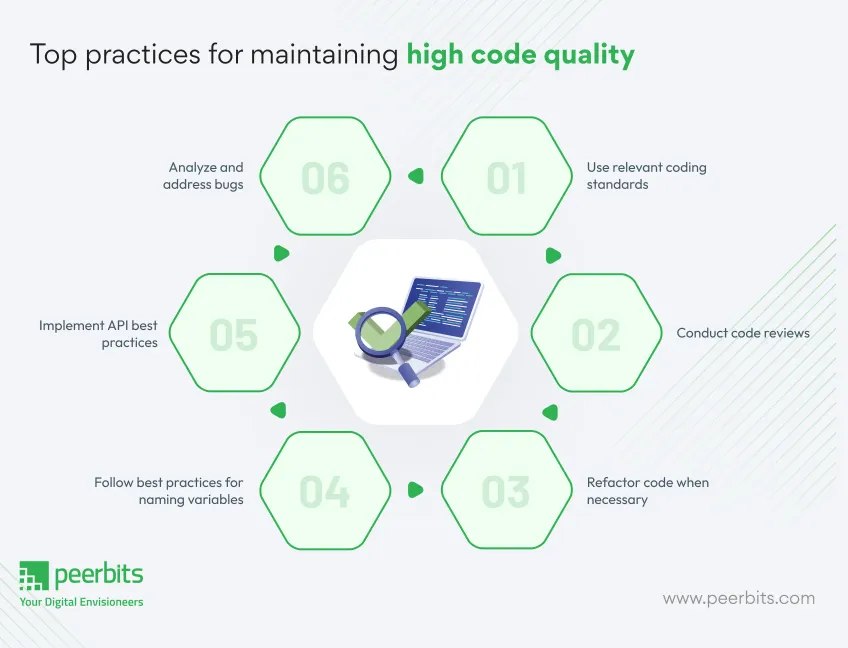Code quality is a key factor in custom software development. It refers to how effective, readable, and maintainable the code is, as well as how well it performs. High quality code does more than just make the software work—it ensures the code is efficient, easy to understand, and can be updated or extended as needed.
In custom software development, focusing on code quality helps ensure the software can scale and adapt over time without the need for major rewrites.
For businesses building custom software, code quality is critical. Well-written code leads to better security, minimizing the risk of vulnerabilities, and improves software performance.
Choosing a reliable software development partner ensures that code quality remains a priority, enabling businesses to build reliable and robust solutions.
It also supports the long-term maintenance of the codebase, making it easier to fix issues and add new features. Businesses that focus on code quality can develop scalable, secure solutions that grow with their needs.
This blog discusses the significance of code quality in custom software development. It explores what defines high-quality code, why it matters for businesses, and how maintaining code quality can result in secure, scalable, and maintainable software.
What is code quality?
In software development, code quality refers to how well the written code meets specific standards of effectiveness, readability, and maintainability.
It is not just about creating code that works but about ensuring it can be easily understood, debugged, and extended as the project evolves.
Code quality forms the foundation for creating software that performs efficiently and remains reliable over time.
Key aspects of code quality extend beyond functionality. These include:
- Readability: Code should be clear and easy for other developers to understand, reducing the learning curve for new team members and aiding collaboration.
- Maintainability: High quality code can be updated or fixed with minimal effort, making it adaptable to future needs or changes in requirements.
- Efficiency: Code should be optimized to perform well without unnecessary consumption of resources like memory or processing power.
- Scalability: Well-structured code supports the growth of the application, accommodating new features or an expanding user base.
- Consistency: Uniform practices in writing code, such as following coding standards, ensure predictability and reduce errors.
Code quality isn’t just about making the software functional today—it’s about building a foundation for sustainable growth and adaptability in the future. These qualities make the codebase an asset rather than a liability.
Key characteristics of quality code
High quality code goes beyond basic functionality by incorporating essential traits that make software secure, efficient, and adaptable. These characteristics help in choosing the right software development partner to achieve dependable and flexible software for future needs.
1. Security
Well-written code significantly reduces security risks and protects against vulnerabilities. Safe coding practices, such as input validation and secure data handling, are critical in preventing breaches or unauthorized access.
Proactive measures during development build a strong defense against potential threats.
2. Performance
Efficient code improves the overall performance of software. Reducing resource consumption, eliminating redundant processes, and using effective algorithms ensure the software runs faster and more smoothly.
For example, optimizing database queries can decrease response times, even for large-scale applications.
3. Readability and clarity
Readable code, with clear organization and meaningful comments, is easier to understand and modify. Developers can quickly identify sections that need updates or debugging.
Using consistent naming conventions and a logical structure ensures that the codebase remains accessible and manageable over time.
4. Maintainability
Code designed for easy updates and issue resolution saves time and effort in the long term. Modular design and reusable components simplify the outsource software development process of adding new features or fixing errors.
This characteristic is critical for adapting software to evolving requirements.
5. Scalability
Scalability lets software grow and support additional features or larger user bases without significant rewrites.
Code designed with scalability in mind ensures that applications remain functional and relevant as business needs expand.
Businesses can build software that is secure, efficient, and ready to adapt to future challenges by focusing on these characteristics.
Why code quality matters in custom software development?
Code quality is essential for successful custom software development. Using software development metrics to measure quality ensures stability, performance, and adaptability while improving team collaboration.
Below are the key reasons why maintaining high standards of code quality is important.
1. Making software stable
High quality code significantly reduces bugs and system failures, ensuring that the software performs reliably. Thoughtful logic, thorough testing, and strong coding practices contribute to applications that can handle real-world conditions with consistency.
Stability is essential for maintaining user trust and reducing maintenance efforts.
2. Improving readability and ease of editing
Readable code simplifies collaboration and future updates. Clear organization, descriptive naming, and meaningful comments make it easy for developers to understand the codebase.
This clarity helps teams work together efficiently and reduces the time needed for modifications or enhancements.
3. Sustainable software
Adopting good coding practices prevents the accumulation of technical challenges that slow down progress. Sustainable code supports long-term growth by allowing the software to adapt to new requirements or changes in technology.
Businesses save time and resources by avoiding repetitive fixes or unnecessary complications.
4. Transferability
Projects often require transitions between teams or organizations. Quality code ensures that these transitions happen smoothly by being easy to understand and modify.
A well-documented and organized codebase helps new developers quickly get up to speed, reducing downtime and maintaining project momentum.
Focusing on code quality in custom software development leads to reliable, adaptable, and long-lasting solutions that serve business needs effectively.

The impact of poor code quality
Poor code quality can lead to significant challenges throughout the software development lifecycle. It affects functionality, security, and long-term maintainability. Learning its impact can help highlight the importance of maintaining high standards.
Good complexity vs. Bad complexity
Knowing the difference between good and bad complexity is essential in software development. Below is a comparison:
| Aspect | Good complexity | Bad complexity |
|---|---|---|
| Code structure | Organized with clear modularity and logical flow. | Disorganized with redundant logic and tangled dependencies. |
| Maintainability | Simple to update and expand with minimal risk of introducing issues. | Difficult to modify or debug, increasing the likelihood of errors. |
| Scalability | Accommodates future growth and new features without extensive rework. | Becomes increasingly difficult to manage as the software grows. |
| Development time | Helps teams collaborate effectively, reducing the time needed for changes. | Requires additional time to understand and adjust, leading to delays and increased costs. |
| Performance | Boosts efficiency by using resources wisely and keeping processes smooth. | Reduces efficiency with poorly written logic and excessive resource usage. |
Consequences of bad code quality
Poor code quality brings a host of risks that can disturb development and operational goals:
- Security vulnerabilities: Weak or sloppy code increases the likelihood of breaches, making applications more susceptible to attacks. For example, poorly sanitized inputs can lead to SQL injection or other exploits.
- Performance bottlenecks: Inefficient code consumes excessive resources, resulting in slower response times and poor user experiences. This can severely impact applications with heavy traffic or complex operations.
- Difficulty in scaling: As software grows, low-quality code becomes harder to modify and expand. New features or updates require more effort and risk introducing errors, delaying progress.
The implications of poor code quality extend beyond the technical field, affecting budgets, timelines, and customer satisfaction. Investing in high quality code from the start prevents these issues, ensuring smooth development and reliable performance.
Best practices for maintaining high code quality
Maintaining high code quality ensures that the software remains reliable and manageable throughout its life. Below are some key practices to follow:

1. Use relevant coding standards
Following industry-standard coding practices is essential for keeping the codebase consistent and easy to follow. These standards improve collaboration across teams and make it simpler for new developers to understand the code.
Consistency reduces errors and simplifies modifications, leading to better long-term results.
2. Conduct code reviews
Code reviews play an important role in identifying issues before they become bigger problems. Regularly reviewing each other’s work helps in catching bugs and inconsistencies early, making it easier to address them promptly.
It also promotes knowledge-sharing within the team, ensuring everyone is on the same page regarding code quality.
3. Refactor code when necessary
Code refactoring helps improve structure and performance by removing unnecessary elements and optimizing logic. As projects grow, parts of the code might become difficult to maintain.
Refactoring addresses this by improving readability and performance, and it reduces the likelihood of future problems.
4. Follow best practices for naming variables
Naming conventions are essential for readability and clarity. Variables should be named clearly to reflect their purpose, helping developers understand their function without needing extra comments.
Consistent naming reduces the chances of errors when modifying or expanding the code.
5. Implement API best practices
APIs are critical for allowing different software components to work together. Implementing API best practices ensures they are easy to integrate and maintain.
Good APIs provide clear documentation, are easy to understand, and are secure, which reduces complexity when working with external services or scaling the application.
6. Analyze and address bugs
Addressing bugs promptly is key to maintaining code quality. Bugs can impact performance, security, and user experience. Implementing code quality assurance practices ensures that bugs are detected and resolved effectively, preventing them from escalating into larger issues.
Regular analysis helps identify the root causes of recurring problems, ensuring they are addressed before causing further disruptions.
These practices not only maintain a clean and efficient codebase but also contribute to creating software that is manageable and dependable over time.
How to maintain code quality consistently
To ensure code quality is maintained consistently throughout the software development process, integrating quality practices from the start is key. Teams can continuously monitor and uphold high standards by applying effective tools and techniques.
Integrate quality practices from the start
Incorporating good practices early in the development cycle is essential for maintaining code quality. Defining coding standards, conducting regular code reviews, and using test-driven development (TDD) are practices that should begin at the outset.
It becomes easier to identify and resolve issues early, avoiding the need for larger changes later by addressing code quality from the beginning.
Applying these practices at every stage helps developers track code quality and prevents the introduction of errors as the software grows. This structured strategy minimizes the chances of problems arising and let teams stay on track and ensure long-term stability.
Tools for code quality
Automated tools can assist in consistently monitoring and improving code quality, allowing developers to identify issues early and ensure the software remains reliable. Here are some tools commonly used for maintaining code quality:
- SonarQube: SonarQube scans code for potential issues, including bugs and vulnerabilities. It provides detailed reports, which help teams track their code quality over time.
- ESLint: This tool checks JavaScript code for syntax and style issues, ensuring consistency and preventing common errors. It can be integrated into the development environment for real-time feedback.
- JUnit: A testing framework for Java, JUnit helps automate unit tests, confirming that components work correctly and that updates do not negatively impact the system.
- Prettier: Prettier is used to automatically format code, ensuring it meets predefined style guidelines, which improves clarity and reduces formatting inconsistencies.
- Checkstyle: This tool is used to enforce coding conventions in Java, ensuring code remains consistent in structure and formatting.
Teams can maintain code quality without adding extra manual effort by incorporating these tools into the development workflow. These tools automatically highlight potential issues, which makes it easier to uphold consistency and improve code reliability.
The long-term benefits of code quality
High-quality code reduces costs, speeds up time-to-market, improves security, and ensures long-term software sustainability.
1. Lower development costs
High-quality code minimizes the need for frequent bug fixes and patching. As a result, developers spend less time addressing issues and more time building new features, leading to cost savings over the long term.
This reduction in debugging efforts directly translates to more efficient resource allocation and a more predictable development process.
2. Accelerated time-to-market
High-quality code speeds up updates and new features. A solid software release plan ensures smooth rollouts, letting developers focus on innovation over recurring issues.
This shortens the time it takes to bring products or updates to market.
3. Enhanced security
Following best practices for code quality directly impacts the security of the software. Quality code reduces the likelihood of vulnerabilities by preventing common coding mistakes that could be exploited.
Proper code reviews, testing, and the use of secure coding standards help make applications more resistant to cyber threats, improving the overall security posture.
4. Sustained software viability
Well-written, maintainable code is essential for long-term software sustainability. With high-quality code, businesses can easily make adjustments or updates to meet changing requirements.
Adding new features, improving performance, or adapting to new technologies, clean and structured code provides the flexibility needed for the software to evolve with the organization’s needs
Conclusion
In custom software development services, code quality plays a crucial role in ensuring stability, security, and ease of maintenance. Businesses can avoid costly issues, streamline development processes, and build software that can scale with evolving needs by prioritizing high-quality code.
It is essential for businesses to incorporate best practices, utilize the right tools, and conduct regular code reviews to maintain quality. Doing so helps create software that is secure and adaptable to future changes.
Investing in code quality today leads to significant long-term benefits, including reduced maintenance costs and smoother updates, ultimately contributing to the ongoing success of your software projects.

FAQs
The code quality comprises the properties and attributes of your code. There is no single standard for code quality as the company's business emphasis and unique demands determine the quality. Ultimately, the business priorities and expectations from the software determine how the code is good or bad.
Coding standards ensure that all developers follow the same set of rules. Thus, even the most inexperienced programmers can readily comprehend, troubleshoot, and maintain the code. Here are the following coding standards you shouldn't miss:
1. Prevents issues from occurring in the first place.
2. Aid in transitioning from detecting problems to developing more resilient software.
3. Ensure using widely acknowledged industry standards to maximize the efforts of others.
Agile software development can magnify the issue of poorly-written code. This is possible due to a lack of adoption of the agile principles, a bad implementation, or the Agile concepts are just not applicable to the firm.
After each sprint, the developers should aim at providing a functional application that is free of bugs.
Each user story has a set of criteria that must be met before the narrative can be accepted. Everyone in the sprint team is on the same page regarding the user stories.
For this reason, it is best to use the Three Amigos method in agile to define requirements and project design clearly. And lastly, code reviews and a high level of code coverage are carried out.








